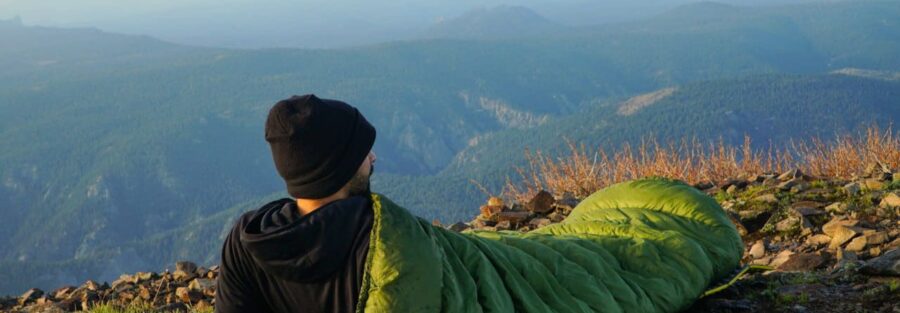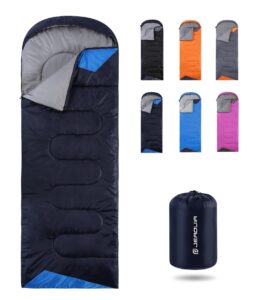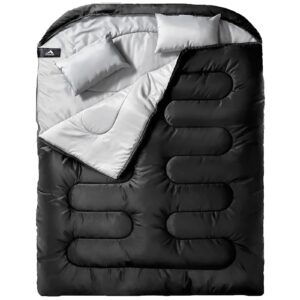Introduction:
A good sleeping bag honestly makes or breaks your night in the wild. Sleeping bags trap warm air close to your body, building a cozy insulation layer so you stay comfortable even when it gets chilly.
The right sleeping bag shields you from cold ground, wind, and moisture. It should also be light enough to toss in your pack for hiking trips.
Temperature rating is probably the biggest factor when picking a camping sleeping bag. This rating shows the lowest temperature where you’ll still feel warm and comfy.
Other features matter too, like insulation type, weight, packed size, and the bag’s shape. It’s a lot to consider, honestly.
Insulation materials really change how a bag performs. Down insulation feels light and packs down super small, but it loses heat when it gets wet.
Synthetic insulation runs heavier, but it’ll keep you warm even if things get damp. We checked out a bunch of sleeping bags and tested them to find the ones that balance warmth, comfort, and value best.
JEAOUIA Lightweight Sleeping Bag
This sleeping bag is a solid pick for budget campers who want something reliable for warm weather trips.
Pros
- Packs down small and fits nicely in a backpack
- Super affordable, so buying a few for the family won’t sting
- Ideal for temps between 50–70°F
Cons
- Not much padding, definitely use a sleeping pad
- Doesn’t keep you warm in cold weather
- Feels basic compared to fancier bags
It kept us comfortable on nights hovering around 45–50°F. There’s enough space for most adults under six feet.
The compression feature is honestly the best part. We squished it down to basketball size, so there was still room for everything else in our pack.
The drawstring hood actually blocks drafts pretty well. But on a night in the low 30s, even with extra layers, NOPE. Lesson learned, don’t trust this bag for real cold.
The thin padding means you’ll definitely notice rocks and roots. For car camping or cabin stays, though, it’s a handy backup. We’ve even used it for kids’ sleepovers and summer campouts.
The price makes it easy to buy extras without worrying about the budget.
Coleman Brazos Sleeping Bag
If you want reliable warmth in mild to cool weather and don’t want to overspend, this is a great pick.
Pros
- Keeps you warm down to 30°F without being bulky
- Machine washable, so cleaning up after muddy campouts is a breeze
- Zip two together for a double-wide bag
Cons
- Cotton fill dries slowly
- Won’t fit campers over 5’11” comfortably
- Rectangular shape isn’t as heat-efficient as mummy bags
Testing the Coleman Brazos on spring trips, we felt plenty warm for the price. The Thermolock draft tube along the zipper really blocks heat loss.
Insulation stayed evenly spread out, even after a few uses, no cold spots or bunching. That’s a relief.
Being able to toss it in the washing machine after a dirty weekend is a huge plus. Packing it up is quick with the stuff sack, though it’s bulkier than pricier, lightweight bags.
MEREZA Double Sleeping Bag
This one’s for couples who want space to sprawl, especially in warmer weather.
Pros
- Splits into two bags for solo sleeping
- Loads of room for tall folks
- Comes with two pillows (not amazing, but better than nothing)
Cons
- Heavy, so not great for backpacking
- Doesn’t handle cold as well as advertised
- Takes up a lot of car or storage space
We used this bag on three trips and loved the roomy feel. The rectangular shape gives you space to move, and two people can sleep without bumping elbows all night.
The zipper system is clever. On a warm night, we split it into two bags. It also works as two big blankets for the campfire.
The included pillows are just okay. They beat using a balled-up hoodie, but don’t expect hotel comfort. At least the pillow pockets keep them from sliding away.
We found it gets too warm if temps climb above 50°F. The foot zipper helps a bit with airflow, but not enough if you run hot.
The weight is honestly a pain, almost eight pounds. We stick to car camping with this one, since carrying it far isn’t fun.
Stuffing it back into the compression sack takes some effort, but the wide opening helps. It’s still easier than some other double bags we’ve tried.
Oaskys 3 Season Sleeping Bag
This bag is a good fit for casual campers who want basic warmth and comfort on a budget.
Pros
- Handy compression sack makes packing less of a headache
- Bottom zipper lets you stick your feet out if you get too hot
- Hood with drawstring keeps your head warm
Cons
- Bulkier than premium bags, even when packed
- Zipper can snag on the fabric sometimes
- Not warm enough for temps below 50°F
The fabric feels sturdy and survived nights on rocky ground. The waterproof outside kept us dry in a light rain.
The hood design actually helps when it gets chilly. We pulled the drawstring tight to block cold air from sneaking in. The bottom foot zipper saved us when things got stuffy.
Packing up was simple with the compression sack. At about three pounds, it’s okay for car camping but not ideal for long hikes.
There’s enough space for most adults to move around without feeling trapped. It’s long enough for people up to six feet. The polyester lining feels smooth and doesn’t get too static-y.
Buying Guide
There are a few key things to keep in mind. The best pick depends on your trip and what you need out there.
|
Model |
Weight |
Temperature Rating |
Best For |
|
JEAOUIA Lightweight Sleeping Bag |
Lightweight (~3 lbs) |
50–70°F (best for warm weather) |
Budget campers & backpackers |
|
Coleman Brazos Sleeping Bag |
Medium (~5 lbs) |
30°F (mild to cool weather) |
Affordable cool-weather camping |
|
MEREZA Double Sleeping Bag |
Heavy (~8 lbs) |
50°F+ (warm weather only) |
Couples car camping |
|
Oaskys 3 Season Sleeping Bag |
Lightweight (~3 lbs) |
50°F (spring/summer use) |
Casual warm-weather camping |
Temperature Rating
Temperature ratings show how warm a bag will keep you. Aim for a bag rated about 10–15 degrees below the coldest weather you expect.
Summer bags are for temps above 35°F. Three-season bags work from 10°F to 35°F. Winter bags take you below 10°F, though honestly, most of us stick to warmer months.
Insulation Type
Here’s the big debate: down or synthetic?
| Down | Synthetic |
|---|---|
| Lighter weight | Heavier |
| Packs smaller | Bulkier |
| Costs more | Costs less |
| Loses warmth when wet | Works when wet |
| Lasts longer | Shorter lifespan |
Size and Fit
Sleeping bags come in all shapes and sizes. Pick one that fits your body, not too tight, not too loose.
Regular bags suit most people up to six feet tall. If you’re taller, go for a long bag. Want more space? Look for a wide version.
Weight and Packed Size
If you’re backpacking, lighter and smaller is always better. Car campers can go for comfort since weight isn’t such a big deal.
Check the weight and how small it packs before buying. Lighter bags cost more, but your back will thank you on the trail.
Shape Options
Rectangular bags give you extra space, though they tend to weigh a bit more. Mummy bags keep things lighter and warmer, but honestly, they can feel a bit snug.
Semi-rectangular bags try to hit that sweet spot between comfort and warmth. It really depends on what matters most to you, space, weight, or just not freezing at night.
So, there you have it. Some of the best sleeping bags for your adventures, plus a few tips for picking the right one. Whether you’re car camping with friends or heading out solo into the woods, there’s a bag out there that’ll help you get a decent night’s sleep. Don’t overthink it, just pick what feels right for your trips, and get out there. Happy camping
Support the Adventure
To make your walls less boring, check out my photography portfolio and bring a piece of the wild and my story into your home.
If you’d like to fuel future adventures, you can donate a coffee on Ko-Fi. Every cup keeps me chasing sunrises and stories.
When you shop using my affiliate links, every click helps support this blog at no extra cost to you. It’s a small way to keep Unicorn Adventure alive and kicking while I keep exploring.
Subscribe to my mailing list for future updates, new stories, and behind-the-scenes adventures.
Stay connected with me on Instagram and Facebook for more photos and daily inspiration.
Thanks for being part of the journey, Unicorn Squadron!






